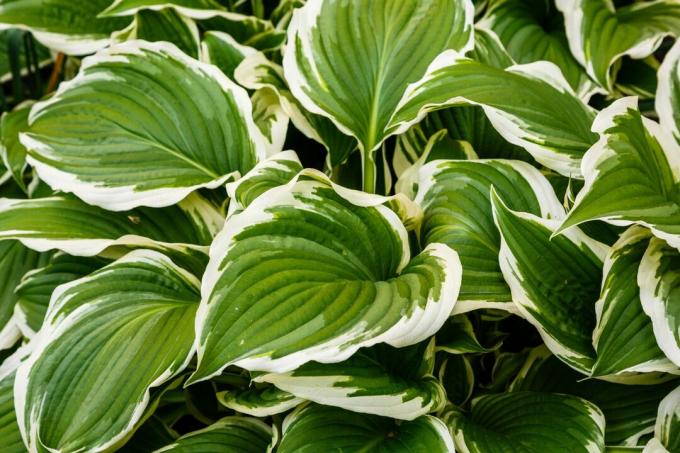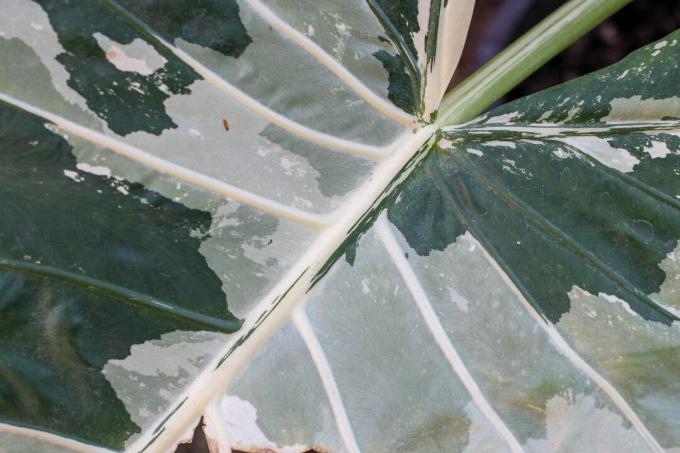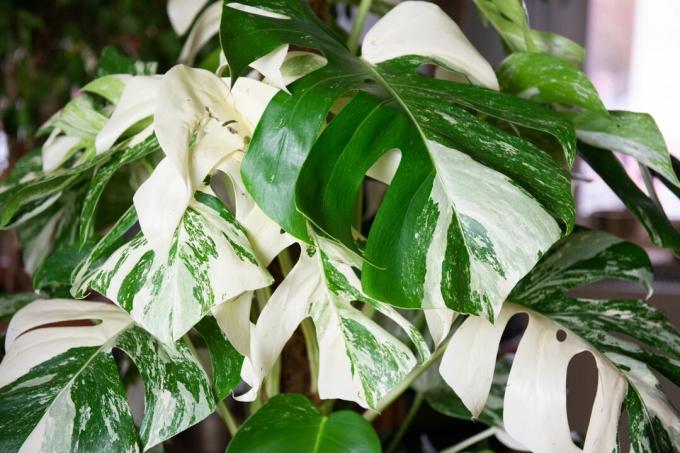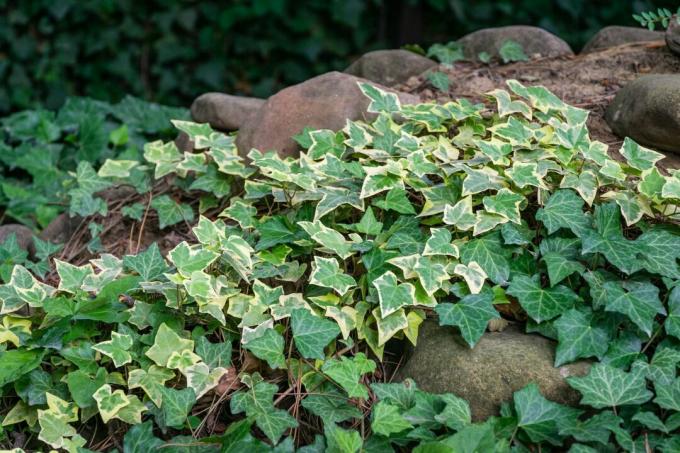A white-green leaf pattern on variegated plants quickly attracts everyone's attention. In this article you will find out what causes the variegation and what should be considered when caring for it.

Plants with white-green colored, mottled or marbled leaves have been known for several hundred years and have always been popular with plant collectors. But how does this leaf drawing come about and what distinguishes 'Variegata' plants? With us you can read about the mechanisms behind the variegation of leaves and which species are suitable as houseplants or for the garden.
contents
- What are variegated leaves?
- Why are the leaves of plants variegated?
-
Variegated plants: list with examples
- List of variegated houseplants
- List of variegated garden plants
- Shrubs with variegated leaves
- Caring for and propagating variegated plants properly
What are variegated leaves?
Variegated leaves do not have a uniform color but are marked with spots, dashes or borders of a different color, usually white. A light green, yellow or reddish variegation is also possible. They can occur symmetrically and regularly, that is, on all leaves. Alternatively, they are uneven, as if random, and variegated to varying degrees.
Many varieties with variegated leaves go by the name 'Variegata'. The Latin term means colourfulness or diversity. The word "variegation", on the other hand, comes from French and can be roughly translated as "to bring variety" or "to mix".

Why are the leaves of plants variegated?
There is no general answer as to why leaves appear variegated. This often requires a microscopic or genetic examination. Botanists are familiar with a wide variety of mechanisms by which a leaf can deviate partially or completely in colour. For example, white spots appear when there is a gap between the top layer of the leaf and the the layer of cells underneath is air, which reflects light and makes the leaf white lets appear. A lack of the green pigment, chlorophyll, can also be the cause. A genetic defect means that the chlorophyll is formed but bleached by chemical processes. If only a single layer of cells is affected, grey-green spots may appear. Spontaneous mutations often only affect a few cells in specific areas. However, if the stem cells are from the leaf bud, they pass on their information to all leaf cells as to whether green pigment should be formed or not. This is why variegated plants sometimes have completely white leaves. How strong the leaf color develops depends primarily on the genes, but also to a certain extent on environmental conditions.
Variegated plants: list with examples
Variegated leaves can be found on a wide variety of plants, including tropical houseplants, perennials, shrubs and shrubs, but also vegetable plants. We present some examples of plants with variegated leaves.
List of variegated houseplants
- alocasia(Alocasia zebrina'Variegata'): Arrow-leaved plant with a red patterned petiole and irregular, green-white marked leaves. The variegated houseplant, like other varieties of the Alocasia zebrina up to 1.5 m high.
- dragon tree (dracaena): Among the dragon trees There are various variegated varieties, including yellow-edged ones like 'Golden Coast' or those with eye-catching white stripes like 'White Jewel'.
- Spiderwort (Tradescantia fluminensis 'Quadricolor'): Creamy-white variegated houseplant with pink stems and pendulous habit.
- ivy (Epipremnum pinnatum 'Happy Leaf' and 'N-Joy'): Varieties of Efeutute with more or less white content in the smooth, shiny leaves of the creeper.

- window leaf (Monstera deliciosa 'Variegata'): Attractive monstera, which offers a special eye-catcher among the variegated plants with large, perforated leaves and conspicuous partial coloring.
- Variegated basket marante (calathea ‘White Fusion’): basket marante with white-green variegated leaves and a typically purple underside.
tip: Variegated plants have the same fertilizer requirements as their green relatives. An organo-mineral liquid fertilizer like our specially formulated Plantura organic indoor & green plant fertilizer can be easily applied with the irrigation water if necessary. The nutrients it contains are quickly flushed to the roots and even provide relief in the event of acute deficiency symptoms.
List of variegated garden plants
- Pineapple Mint (Mentha suaveolens 'Variegata'): Fruity mint with a growth height of
30 - 60 cm, refreshing pineapple aroma and pretty, white-edged leaves. - Colorful Sage (Salvia officinalis 'Tricolor'): garden sage variety with white variegated leaves and purple shoots, giving the plant a three-colored appearance.
- Hostas (hosta): Among the ornamental leaf perennials there are various varieties with white, yellow or light green variegated leaves such as 'Patriot', 'Gold Standard' or 'El Nino'.
- Variegated tomatoes (Solanum lycopersicum): Among the tomatoes there are now some varieties with variegated foliage, even the calyxes show a creamy-white pattern. Varieties with variegation are, for example, 'Faelan's First' or 'Painted Lady'.

- Variegated sedge (Carex): Evergreen grasses with white to yellow striped, dark green leaves. Different types and varieties with variegation are available.
- Variegated periwinkle (Vinca minor 'Variegata'): Slightly frost-sensitive groundcover with evergreen, creamy white-edged leaves and blue-violet flowers.
- White-and-white Caucasus forget-me-not (Brunera macrophylla 'Dawson's White'): Light blue flowering forget-me-not up to 40 cm high with large, heart-shaped, variegated leaves.
- White Pied Reed (Arundo donax 'Variegata'): Up to 300 cm high grass with conspicuous white stripes on leaves and stems. In harsh winters, shelter or frost-free overwintering is necessary.

Shrubs with variegated leaves
- Harlequin willow (Salix integra 'Hakuro Nishiki'): ornamental willow up to 3 m in height and oblong leaves, which are initially white and pink patterned and later turn green-white.
- marshmallow (Hibiscus ‘Purpureus Variegatus’): Hibiscus variety up to 2 m high and dark red, double flowers. The variegated shrub prefers a warm location.
- climbing spindle (Euonymus fortunei 'Variegatus'): Creeping to climbing shrub, up to 30 cm high, evergreen, grey-green to silver-white marbled. The shoot is edged in pink.
- Variegated Ivy (Hedera helix 'Glacier'): Vigorous, evergreen ivy with heart-shaped, white-marginated and silver-grey-green marbled, heart-shaped leaves. Yellow-variegated ivy varieties such as 'Gold Child' are also available.

- Silver Ash Maple (Acer negundo 'Variegatum' and 'Flamingo'): Small-crowned maple with irregularly white-edged to marbled, green leaves, which are pink when they sprout in spring.
- holly (Ilex aquifolium 'Silver Queen'): Evergreen variegated ilex up to 4 m in height with small, grey-green marbled leaves with white margins and no thorns and spherical, orange-red fruits.
- weigela (Weigelia florida 'Nana Variegata'): One of the few variegated shrubs with numerous white-pink flowers and a very compact growth habit of up to 2 m for weigela.
- White Dogwood (Cornus alba ‘Sibirica Variegata’): Dogwood Art with irregular creamy-white margins, grey-green leaves, some of which are tinged with reddish-pink.

Caring for and propagating variegated plants properly
Variegated plants have exactly the same soil and nutrient requirements as their normally colored relatives. In general, a heavily variegated plant with a high proportion of white will not grow as vigorously and be as vital as a purely green or slightly variegated plant. This is because with less chlorophyll, less sugar is also made through photosynthesis. However, if you attach particular importance to variegation, you should keep a few things in mind when caring for and keeping variegated plants:
- Sufficient light, otherwise the new leaves may turn green and the variegation will gradually become less or disappear.
- No direct sunlight on indoor plants, as white parts of the leaves are more sensitive and react more quickly with sunburn.
- If possible, propagate vegetatively via cuttings, offshoots or division in order to obtain genetically identical plants with the same leaf markings.
- Cut back shoots that show no variegation and only take cuttings from shoots with the desired leaf color.
- In plants grown from seed, variegation may no longer occur due to reverse mutation or crossbreeding.

The zebra weed (Tradescantia zebrina) also has a striking leaf pattern and is particularly suitable as a hanging houseplant. You can find out from us what requirements the zebra herb has and how best to care for it.



